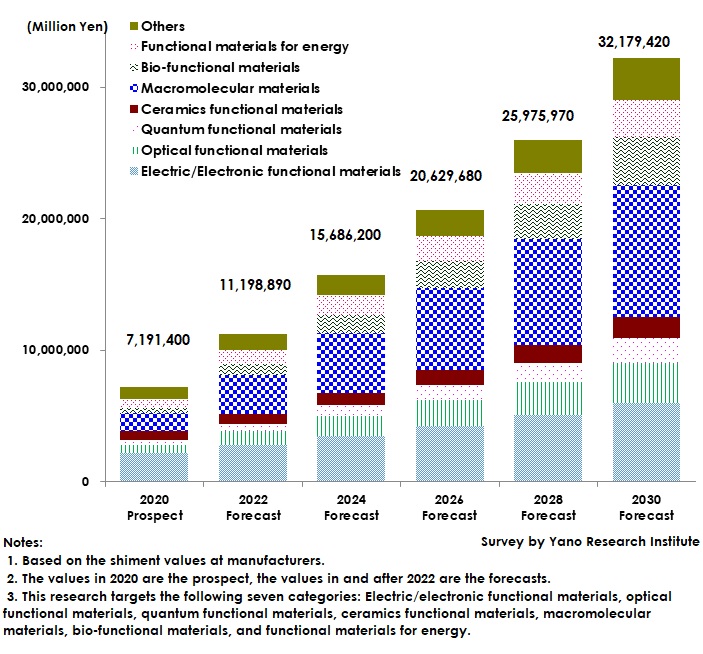No.2600
Global Market of Next-Generation High-Performance Materials: Key Research Findings 2020
Global Market Size of Next-Generation High-Performance Materials Forecasted to Achieve 32,179,420 Million Yen by 2030
Yano Research Institute (the President, Takashi Mizukoshi) carried out a survey on the global market of next-generation high-performance materials and disclosed seven target materials by category, trends of R&D institutions and companies in the market, and future perspectives.

Market Overview
The global market size of next-generation high-performance materials in 2020 based on the shipment values at manufacturers is projected to attain 7,191,400 million yen.
In general, functional materials refer to those materials related with physical quantity of electricity, magnetism, light and heat. Therefore, the definition of such materials should be broad, but when eyeing on promising functional materials for the next generation (i.e. next-generation high-performance materials), the materials can be those that respectively have unique functions and that contribute to advancement of science and industries. This research targets the following seven categories: Electric/electronic functional materials, optical functional materials, quantum functional materials, ceramics functional materials, macromolecular materials, bio-functional materials, and functional materials for energy.
Electric/Electronic functional materials refer to those materials used in electric power equipment and electronic devices, such as materials for components and devices that form electric or electronic appliances including PCs, mobile phones, liquid-crystal-display televisions, etc. The range of such materials is extremely wide, from state-of-the-art semi-conductor materials and display materials to the materials for solar cells that represent new energy. Therefore, these materials occupy the largest share in the global market size (prospect) by category, as of 2020.
Quantum functional materials are basically those materials that show quantum behaviors or the materials generated through the process utilizing quantum science and technology, and many of them have already been implemented in the real world. In addition to these, new quantum functional materials are created one after another for the next generation. Quantum science and technology is not for understanding the nature, but it is a science that study and promote quantum mechanics together with quantum behaviors and their influences, and proactively operate quantum, aiming to contribute to diverse fields in industries, including academic disciplines.
Noteworthy Topics
Macromolecular Materials Show Various High Functions Such as to Recognize, Convey, and Convert Information or Molecules
Many of high molecular compounds are often used as raw materials of synthetic resin, synthetic fiber, synthetic rubber, etc. In contrast, those macromolecules with special functions and with small portions used are called macromolecular materials for convenience to distinguish from high molecular compounds.
Macromolecular materials are generally those macromolecules or composite materials of such macromolecules that are available to convey, transform, or store some substances, energy, and information. To be more specific, they are those macromolecules or composite macromolecules materials that have diverse functions such as chemical reaction activity, photosensitivity, electric conductivity, catalytic property, biocompatibility, medicinal properties, selective isolation, energy conversion, magnetic properties, etc.
Among macromolecular materials, stimuli-responsive polymers attract attention as a next-generation macromolecular material that can reversibly change their properties in response to external stimuli.
There are many stimuli-responsive polymers such as temperature responsive polymers, pH responsive polymers, and electric charge responsive polymers. There have been some attempts to generate new materials that are responsive to external stimuli aiming to apply to various fields including medical applications. An example is the use of thermo-responsive polymers in combination with cancer hyperthermia, a type of cancer treatment in which body tissue affected by cancer cells is exposed to high temperatures. The combined treatment is expected to be highly effective on the condition that thermos-responsive polymers are required to be strictly-responsive to a certain temperature, not to mention to be biocompatible.
Future Outlook
The global market size of next-generation high-performance materials is forecasted to attain 32,179,420 million yen by 2030 based on the shipment values at manufacturers.
When observing the market size by material category in 2030, the largest market share is forecasted to be occupied by macromolecular materials. Among such macromolecular materials, those that are likely to occupy the upper rankings (based on the shipment values) are polymer films, and those macromolecular materials for displays and for semiconductors.
On the other hand, among the global market size (forecast) of next-generation high-performance materials by material category in 2030, the largest growth rate in comparison with 2020 are bio-functional materials. In particular, the growth rates of biocompatible materials, materials for DDS (Drug Delivery Systems), and materials for regenerative medicine are all projected to exceed 1,000% of, or 10 times more than 2020. It is because these materials are the areas where the technologies remarkably advance during the next decade, and have the potential to give a tremendous impact to change the current medicines dramatically.
* DDS (Drug Delivery System) refers to the system that controls drug delivery to the body in terms of quantity, space, and time.
Research Outline
2.Research Object: R&D institutions studying next-generation high-performance materials, the companies and manufacturers dealing in such materials
3.Research Methogology: Face-to-face interviews by the expert researchers, and literature research
The Next-Generation High-Performance Materials Market
The next-generation high-performance materials market refers to the market of those characteristic and functional materials promising in the next generation: 1) Electric/Electronic functional materials, 2) optical functional materials, 3) quantum functional materials, 4) ceramics functional materials, 5) macromolecular materials, 6) bio-functional materials, and 7) functional materials for energy, etc. The global market size is calculated based on the shipment values at manufacturers.
Published Report
Contact Us
The copyright and all other rights pertaining to this report belong to Yano Research Institute.
Please contact our PR team when quoting the report contents for the purpose other than media coverage.
Depending on the purpose of using our report, we may ask you to present your sentences for confirmation beforehand.